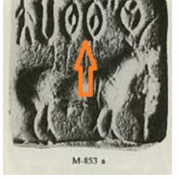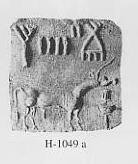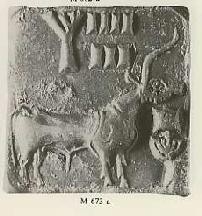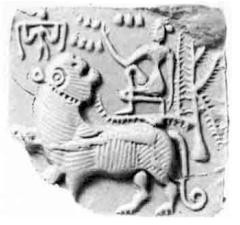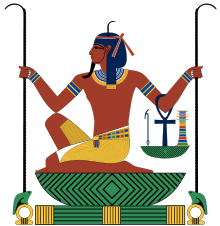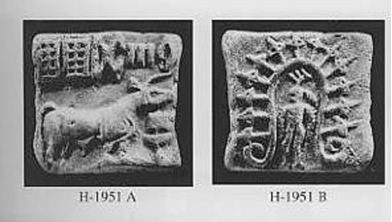Branch symbol indicates the word ‘Sastha’
‘Branch symbol’ indicates the word ‘Sastha.’

The above given two symbols indicate branches of a tree. The Sanskrit word ‘Zakhastha’ means ‘branch-sitting’ that is the god sitting on a branch. Further, it is likely that this word got distorted and being pronounced as ‘Sastha’ in Tamil Nadu and Kerala as on today. There were three tree living gods in IVC as per my article, ‘Three different tree living gods of Indus civilization’ (1). It looks like that the referred three gods alone are not called as ‘Sasthas’, all the gods of Indus civilization were called as ‘Sasthas.’
Out of the two symbols presented above, the second symbol looks like a ‘Trishul symbol.’ However, verification so far, reveals the fact that this symbol is a modified form of the branch symbol and not a ‘Trishul’ symbol.
See the research paper of Sundar et al. (Sundar, 2010). This paper analyses the frequency distribution of various symbols and also a combination of symbols. (2) I have listed out combinations of symbol and
symbol separately. Even though the second symbol looks like ‘Trishul’, it is only ‘branch symbol’. However, it looks like that over centuries this ‘zakha’ symbol got transformed into ‘Trishul symbol’. However, in the Indus seal inscriptions, evidence of Trishul as a weapon is not seen so far. Details about ‘Zakha’ [
] (Branch) symbol are as following:
| Symbol combinations | frequency | Symbol combinations | Frequency |
| 48 | 54 | ||
| 47 | 40 | ||
| 30 | 30 | ||
| 26 | 21 | ||
| 24 | 20 | ||
| 18 | 10 | ||
| 15 | 10 | ||
| 11 | 10 |
Table 1: Frequency distribution analysis of ‘Branch Symbol’.
One significant observation that can be made is, “there is no difference between symbol and
symbol; both symbols had been used in an interchangeable fashion”. That means both these symbols are indicating the same meaning that these symbols indicate the word ‘’ God’’ (Sastha).
The second important point obtained out of this analysis is that this symbol ‘Sastha’ is not appearing with those other two gods, namely, Dwara Palaka (gatekeeper god) [
] and Karkinos [
]. The third important point is that the ‘The istika ceremony’ [
] is associated with all gods( Sasthas). It means that the word ‘Sastha’ is a generic term meant for the word ‘God’.
In the above-given seal, a branch is placed on a pedestal, which stands for the word ‘Sastha’. The chakra symbol indicates the ‘Grihapathya fire’. It means that the sacrifice was carried out on a general basis, and the sacrifice was made for all gods, no particular god is mentioned.
In this inscription, the branch symbol is located in the last (read from right to left). The bangle symbol may be indicating ‘mother goddess’. It looks like that mother goddess was also called as ‘Sastha’. (or) The sacrifice was made only for gods (Sasthas), not Pithru.
God is mentioned as the first symbol (Read from right to left). It is a new symbol, and god has not been identified so far. It looks like another symbol for God Astaka. The ‘Branch symbol’ merely stands for the word ‘Sastha’, which indicates that the sacrifice was made only for gods and not Pithrus. Number four may be indicating the fourth-day of Pithru ceremony (or) fourth-day Sastha. The fourth-day god is Yama/Ganapathi. (3) Yama/Ganapati is lord of the 4th lunar day as per modern Hindu religious ideas, which is suitable for the destruction of one’s enemies, the removal of obstacles, and acts of combat.
Karkinos was the god who lived in the Pipal tree during Indus valley civilization times. Now the gods residing under Pipal tree should be taken as continuity of the old god. Modern Hindu god Ganapathi fills that role very well. Equally important is the Tamil ancestral god Muneeswaran, he also fills the same spot.
Palm branch symbol – a measure of time
There is a second possibility that this Indus branch symbol 
Figure 2: Palm branch symbol as per Egyptian Hieroglyphics.
The Egyptians would put a notch in a palm branch to mark the passing of a year in the life of a pharaoh. It symbolized the ‘measure of time.’ (4)
Figure 1: Seal inscription showing number along with branch symbol.
In the above-given seal inscription, the number seven symbol is appearing in association with ‘Sastha'(God) symbol. It could be indicating the seventh-day god, as per Hindu religious idea. (or) it could mean the number of years as a measurement of time.
Heh (god)
Ḥeḥ was the personification of infinity or eternity in the Ogdoad in Egyptian mythology. (1) His name originally meant “flood”, referring to the watery chaos that the Egyptians believed existed before the creation of the world. (2) The Egyptians envisioned this chaos as infinite, in contrast with the finite created world, so Heh personified this aspect of the primordial waters. (3) (4)
Like the other concepts in the Ogdoad, his male form was often depicted as a frog, or a frog-headed human, and his female form as a snake or snake-headed human. The frog head symbolized fertility, creation, and regeneration. (4) The other common representation depicts him crouching, holding a palm stem in each hand (or just one), (5) sometimes with a palm stem in his hair, as palm stems represented long life to the Egyptians, the years being represented by notches on it. (4)
The representation of this god crouching (kneeling-One knee raised) brings to my mind similar depiction in
Indus seal image.
See the above-given representation of the god sitting in the tree. His sitting position is very similar to the Egyptian god ‘Heh’, who gives a million years afterlife. Hence, it can be concluded that the above-depicted god is a continuation of the Egyptian god ‘Heh’. We do not know, by what name the Indus valley people called him, but we can call him by his Egyptian name, till a consensus is arrived.
An aspect of Heh, holding a pair of notched palm branches
The god Ḥeḥ was usually depicted anthropomorphically, as in the hieroglyphic character, as a male figure with divine beard and lappet wig. Typically kneeling (one knee raised), sometimes in a basket—the sign for “all”, the god typically holds in each hand a notched palm branch (palm rib). (These were employed in the temples for ceremonial time-keeping). (7) Occasionally, an additional palm branch is worn on the god’s head. (4)
The personified, somewhat abstract god of eternity. The god’s image and its iconographic elements reflected the wish for millions of years of life or rule. ‘Heh’ became associated with the King and his quest for longevity. The placement of ‘Heh’ in connection with a Pharoah’s corpse means that the god will be granting him these “millions of years” into the afterlife.[9] (4)
The specific identification mark for the god ‘Heh’ is the ‘palm branch on the head’ as shown in the logogram. The above-given seal also shows a god with a palm branch in his head. This god could be ‘Heh’. There are some other gods with similar feathers in their heads. The first one is the goddess of justice ‘Maat’, and the second god is ‘Bes’ the gatekeeper god. Till a finality is reached on this issue, let us assume that the god depicted in the above-given seal is ‘Heh’, the god of immortality.
Acknowledgements:
All the seal pictures are taken out of the book of Sue Sullivan (5)
All symbols are taken out of the book of Asko Parpola (6)
1. Jeyakumar(Three-tree-gods). https://www.academia.edu/25651400/Three_different_tree_gods_of_Indus_civilization. https://www.academia.edu. [Online], 2017. https://www.academia.edu/25651400/Three_different_tree_gods_of_Indus_civilization.
2. Sundar. -The-Indus-Script-Text-and-Context.pdf. http://45.113.136.87/wp-content/uploads/. [Online] http://45.113.136.87/wp-content/uploads/43-The-Indus-Script-Text-and-Context.pdf.
3. Jeyakumar(Table-Thithi-Dates). A_correlation_table_of_different_Thithi_Dates_with_different_Hindu_gods. academia.edu. [Online], 2017. https://www.academia.edu/31708667/A_correlation_table_of_different_Thithi_Dates_with_different_Hindu_gods.
4. Egyptsymbols. www.crystalinks.com. [Online] https://www.crystalinks.com/egyptsymbols.html.
5. Wilkinson, Richard H. The complete gods and goddesses of ancient Egypt. London: Thames & Hudson. , 2003. ISBN 978-0-500-05120-7.
6. Genesis in Egypt, The Philosophy of Ancient Egyptian Creation Accounts. Yale Egyptological Seminar, 1988. Allen, James.P (1). Yale University: Yale Egyptological Seminar, 1988, 1988.
7. Allen, James P.(2). Middle Egyptian: An Introduction to the Language and Culture of Hieroglyphs. Cambridge: Allen, James P. Middle Egyptian: An Introduction to the Language and Culture of Hieroglyphs. Cambridge University Press, 2000, 2000.
8. Wikipedia(Heh_god). Heh_(god). Wikipedia.org. [Online] https://en.wikipedia.org/wiki/Heh_(god).
9. Rush, John. The Twelve Gates: A Spiritual Passage Through the Egyptian Books of the Dead. Berkely, CA: Frog, 2007.
10. Owusu, Heike. Egyptian Symbols. New York. : Sterling., 2008.
11. Remler, Pat. Egyptian Mythology, A to Z. New York. : Chelsea House., 2010.
12. Sullivan, Sue. Indus Script Dictionary. S .l. : Suzanne Redalia, 2011.
13. Parpola, Asko. Deciphering the Indus Script. New Delhi: Cambridge University Press, 2000.

